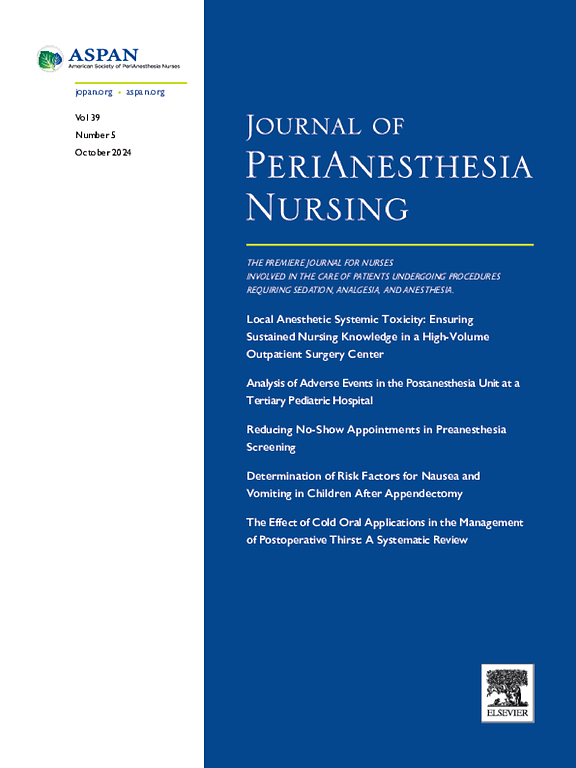小儿外科护士在护理交接中实施和评估 SBAR 沟通模式。
IF 1.6
4区 医学
Q2 NURSING
引用次数: 0
摘要
目的:"情况、背景、评估、建议"(SBAR)被推荐为改善医疗专业人员之间沟通和提高患者安全的标准化模式。正确使用 SBAR 模型可以减少沟通错误,促进快速决策,提高患者安全。因此,医护人员有效使用 SBAR 模型有助于提高患者安全。本研究探讨了儿科手术护士在护理交接中实施和评估 SBAR 沟通模式的情况:研究采用前测-后测半实验设计:数据收集于2022年4月1日至6月30日,来自土耳其一家培训研究医院两个小儿外科的24名护士。研究前已获得伦理批准和书面知情同意:护士的平均年龄为 26.00 ± 3.43 岁,75% 为女性。交接班评分量表的平均得分为 60.33 ± 11.11(18 至 70 分)。SBAR 沟通模式问卷的测试前和测试后得分分别为 60.00 ± 20.64(20 至 90)和 92.50 ± 9.89(60 至 100)。66.7%的护士对 "使用 SBAR 沟通模式没有对交接工作起到积极作用 "这句话的回答是否定的。除这句话外,大多数人对其他项目的回答都是肯定的,对 "SBAR 沟通模式导致我在交接班时浪费时间 "这句话回答肯定和否定的比例相同,大多数人都填写了 SBAR 交接班表:结论:一些护士认为 SBAR 沟通模式对交接班工作起到了积极作用,而另一些护士则认为没有。虽然半数护士认为 SBAR 沟通模式浪费时间,但据观察,在使用该模式期间没有发生负面事件,而且护士们愿意使用 SBAR 沟通模式。因此,建议组织在职培训计划以增加 SBAR 沟通模式的使用,并对 SBAR 的使用进行持续审查和改进。本文章由计算机程序翻译,如有差异,请以英文原文为准。
Implementation and Evaluation of the SBAR Communication Model in Nursing Handover by Pediatric Surgery Nurses
Purpose
Situation, Background, Assessment, Recommendations (SBAR) is recommended as a standardized model to improve communication between health professionals and increase patient safety. Correct use of the SBAR model reduces communication errors, facilitates rapid decision-making, and increases patient safety. Therefore, effective use of the SBAR model among health care professionals contributes to safer patients. This study examines the implementation and evaluation of the SBAR communication model in nursing handover by pediatric surgical nurses.
Design
The study had a pretest-post-test semi-experimental design.
Methods
Data were collected between April 1 and June 30, 2022 from 24 nurses, who worked at two pediatric surgery units of a training research hospital in Turkey. Ethical approval and written informed consent were obtained prior to the study.
Findings
The mean age of the nurses was 26.00 ± 3.43 years and 75% were female. The mean score obtained from the handover rating scale was 60.33 ± 11.11 (18 to 70). The pretest and post-test scores obtained from the SBAR communication model questionnaire were 60.00 ± 20.64 (20 to 90) and 92.50 ± 9.89 (60 to 100), respectively. 66.7% of the nurses answered no to the statement “Using the SBAR communication model did not contribute positively to the handover.” The majority answered yes to the items other than this statement, the ratio of those who answered yes and no to the statement “The SBAR communication model caused me to waste time during the handover” was equal, and the majority completed the SBAR handover form.
Conclusions
Some of the nurses felt that the SBAR communication model made a positive contribution to shift performance, while others felt that it did not. Although half of the nurses considered the SBAR communication model to be a waste of time, it was observed that no negative events occurred during the use of the model and that the nurses were willing to use the SBAR communication model. Therefore, it is recommended that in-service training programs be organized to increase the use of the SBAR communication model and that the use of SBAR should be continuously reviewed and improved.
求助全文
通过发布文献求助,成功后即可免费获取论文全文。
去求助
来源期刊

Journal of Perianesthesia Nursing
NURSING-
CiteScore
2.20
自引率
17.60%
发文量
279
审稿时长
90 days
期刊介绍:
The Journal of PeriAnesthesia Nursing provides original, peer-reviewed research for a primary audience that includes nurses in perianesthesia settings, including ambulatory surgery, preadmission testing, postanesthesia care (Phases I and II), extended observation, and pain management. The Journal provides a forum for sharing professional knowledge and experience relating to management, ethics, legislation, research, and other aspects of perianesthesia nursing.
 求助内容:
求助内容: 应助结果提醒方式:
应助结果提醒方式:


